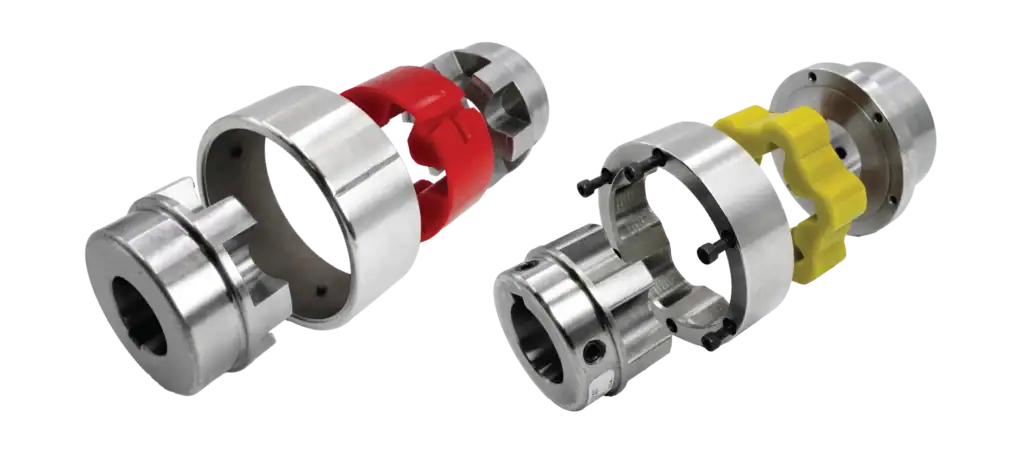Flexible Couplings Explained: Types, Benefits & Why Atra-Flex® Outperforms Competitors

Flexible couplings may often get overlooked, but they play a significant role in keeping industrial systems running smoothly. From motors and pumps to gearboxes and conveyors, they ensure reliable torque transmission, protect equipment from misalignment or torque overloads, and extend machinery life. Choosing the right coupling doesn’t just improve performance. It helps minimize downtime, cut maintenance costs, and boost overall efficiency.
In this guide, we’ll break down the most common types of flexible couplings, explain how they manage torque and misalignment, and highlight why Atra-Flex® couplings from U.S. Tsubaki stand out as a durable, low-maintenance solution.
What Is a Flexible Coupling and How Does it Work?
A flexible coupling is a mechanical device used to connect two shafts to transmit torque from one to the other while accommodating for misalignment. Couplings may also act as a mechanical fuse to protect the connected equipment by providing a break point if a severe torque overload occurs. Couplings also can dampen torsional vibration and absorb shock loads. There is a trade-off between different coupling types as each have their own advantages and disadvantages.
- Transmit torque between two rotating elements
- Compensate for misalignment between shafts
- Dampen vibrations and absorb shock loads
- Protect connected components from overload or failure
Understanding Coupling Misalignment
No two shafts are perfectly aligned. Thermal expansion, wear, vibration, or foundation settling can occur over time. Shaft misalignment, if not properly accounted for can cause premature coupling failure or damage to the connected equipment. Couplings must compensate for three main types of misalignment:
- Angular Misalignment
Occurs when the two shaft center lines are at an angle to each other. - Parallel (Radial) Misalignment
Happens when the shafts are parallel but offset between the center line of each shaft. It can occur in the horizontal and vertical planes. - Axial Misalignment
Refers to shaft movement axially. Axial misalignment can be caused by thermal growth or motor rotor float.
Couplings that can handle all three misalignment types, without sacrificing torque capacity or requiring extensive maintenance, are especially valuable in industrial settings.
Flexible Coupling Types
Here are the most common coupling types and their applications:
| Coupling Type | Best For | Pros | Cons |
|---|---|---|---|
| Rigid Couplings | Precisely aligned shafts | Simple, cost-effective, no backlash | Cannot accommodate any misalignment; no shock dampening |
| Tire style elastomeric coupling | General-purpose use with moderate misalignment | Absorbs shock, lower bearing reactionary loads | Limited torque handling; larger outer diameter |
| Gear Couplings | High-torque with moderate misalignment | Torque dense and compact | Require frequent lubrication, inspections, and replacements driving up costs, labor and downtime |
| Grid Couplings | Medium to heavy-duty drives with vibration | Shock-absorbing, durable | Require frequent lubrication, inspections, and replacements driving up costs, labor and downtime |
| Disc Couplings | High-speed, precision machinery | Torsionally stiff, no backlash, no lubrication needed | Lengthy installation time due to low misalignment capacity and high tightening torque; can be costly, no shock dampening |
| Atra-Flex | Versatile for industrial applications and demanding high torque applications | Low maintenance, protects connected equipment, dampens vibration, easy to install | Not designed for zero-backlash applications |
Key Features to Look for in a Flexible Coupling
When selecting a coupling, consider the following features to ensure the best performance and longevity:
- Torque transmission rating
- Ease of installation and maintenance
- Vibration and shock absorption
- Temperature and chemical resistance
- Lubrication requirements
Elastomeric designs like Atra-Flex® often provide the best balance of performance, reliability, and simplicity.
Why Choose Atra-Flex® Couplings?
Atra-Flex® couplings are a premium elastomeric solution designed for demanding industrial environments. They combine reliability, quick installation, and minimal maintenance.
Advantages of Atra-Flex®:
- Minimal maintenance – no lubrication required
- Split-insert design – allows fast installation and easy replacement without moving hubs or connected equipment, reducing downtime
- High torque capacity – suitable for demanding applications
- Misalignment tolerance – handles angular, parallel, and axial misalignment
- Excellent damping – reduces shock, vibration, and noise while protecting connected equipment
Industries That Rely on Atra-Flex® Couplings for Performance
Atra-Flex® is trusted across a wide range of industries, including but not limited to:
- Pulp & paper
- Dredging
- Forestry
- Oil & gas
- Steel
- Food & beverage
- Water treatment
- Mining & aggregates
- Chemical processing
Whatever the industry, Atra-Flex® delivers reliable performance, reduced downtime, and cost-efficiency.
Find the Right Coupling for Your Needs
The right shaft coupling can mean the difference between frequent breakdowns and a smooth-running system. Whether you need to handle misalignment, high torque, or reduce maintenance, Atra-Flex® couplings provide a trusted, high-performance solution.
Ready to minimize downtime? Explore Atra-Flex® Couplings at U.S. Tsubaki and connect with our application specialists for personalized recommendations here.
Try our Coupling Selector Tool today to identify the best option for your application.

Comments are closed